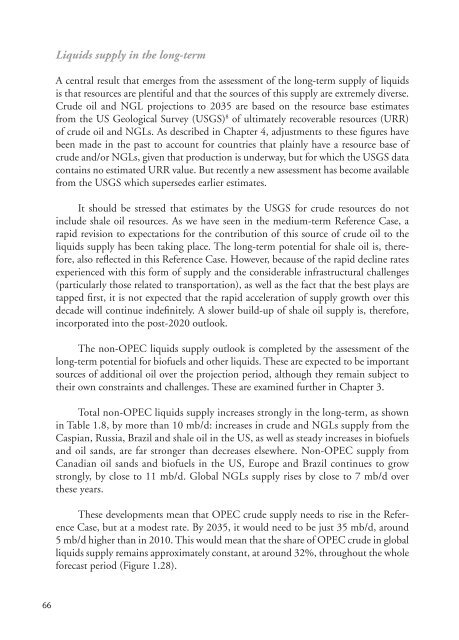World Oil Outlook - Opec
World Oil Outlook - Opec
World Oil Outlook - Opec
- TAGS
- world
- outlook
- opec
- www.opec.org
You also want an ePaper? Increase the reach of your titles
YUMPU automatically turns print PDFs into web optimized ePapers that Google loves.
66<br />
Liquids supply in the long-term<br />
A central result that emerges from the assessment of the long-term supply of liquids<br />
is that resources are plentiful and that the sources of this supply are extremely diverse.<br />
Crude oil and NGL projections to 2035 are based on the resource base estimates<br />
from the US Geological Survey (USGS) 8 of ultimately recoverable resources (URR)<br />
of crude oil and NGLs. As described in Chapter 4, adjustments to these figures have<br />
been made in the past to account for countries that plainly have a resource base of<br />
crude and/or NGLs, given that production is underway, but for which the USGS data<br />
contains no estimated URR value. But recently a new assessment has become available<br />
from the USGS which supersedes earlier estimates.<br />
It should be stressed that estimates by the USGS for crude resources do not<br />
include shale oil resources. As we have seen in the medium-term Reference Case, a<br />
rapid revision to expectations for the contribution of this source of crude oil to the<br />
liquids supply has been taking place. The long-term potential for shale oil is, therefore,<br />
also reflected in this Reference Case. However, because of the rapid decline rates<br />
experienced with this form of supply and the considerable infrastructural challenges<br />
(particularly those related to transportation), as well as the fact that the best plays are<br />
tapped first, it is not expected that the rapid acceleration of supply growth over this<br />
decade will continue indefinitely. A slower build-up of shale oil supply is, therefore,<br />
incorporated into the post-2020 outlook.<br />
The non-OPEC liquids supply outlook is completed by the assessment of the<br />
long-term potential for biofuels and other liquids. These are expected to be important<br />
sources of additional oil over the projection period, although they remain subject to<br />
their own constraints and challenges. These are examined further in Chapter 3.<br />
Total non-OPEC liquids supply increases strongly in the long-term, as shown<br />
in Table 1.8, by more than 10 mb/d: increases in crude and NGLs supply from the<br />
Caspian, Russia, Brazil and shale oil in the US, as well as steady increases in biofuels<br />
and oil sands, are far stronger than decreases elsewhere. Non-OPEC supply from<br />
Canadian oil sands and biofuels in the US, Europe and Brazil continues to grow<br />
strongly, by close to 11 mb/d. Global NGLs supply rises by close to 7 mb/d over<br />
these years.<br />
These developments mean that OPEC crude supply needs to rise in the Reference<br />
Case, but at a modest rate. By 2035, it would need to be just 35 mb/d, around<br />
5 mb/d higher than in 2010. This would mean that the share of OPEC crude in global<br />
liquids supply remains approximately constant, at around 32%, throughout the whole<br />
forecast period (Figure 1.28).
















